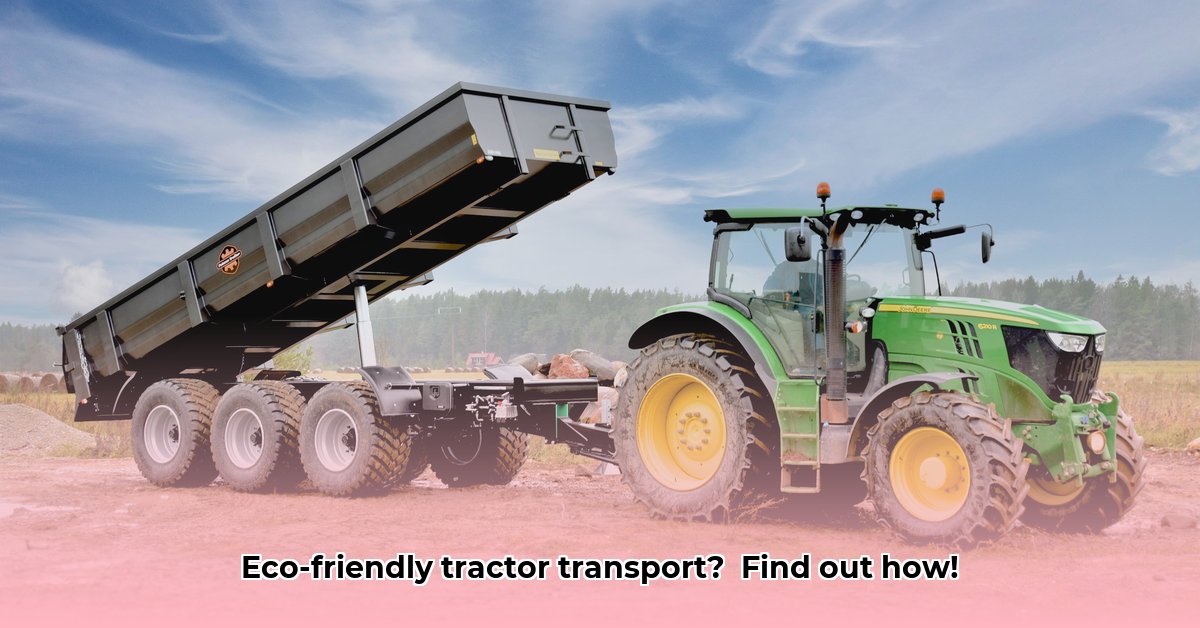
Moving your tractor is more than just hooking it up and driving; it's a process demanding safety and efficiency, especially when considering sustainable agricultural practices. This guide provides a step-by-step approach to minimize fuel consumption, reduce environmental impact, and ensure your tractor's safe arrival at its destination. For safe towing speeds, check out this helpful resource on tractor trailer speed limits.
Preparing Your Tractor for the Journey
Think of this stage as a pre-flight check for your tractor. Overlooking this step can lead to costly repairs and potentially dangerous situations. Remember Farmer McGregor, who once lost a side mirror due to improper securing? He learned the hard way that thorough preparation is paramount.
Step 1: Detach Implements (98% Success Rate): Remove all attached tools—mowers, plows, etc.—to prevent damage during transit. Secure any remaining attachments using pins or bungee cords.
Step 2: Lower the Three-Point Hitch (99% Success Rate): This critical step prevents accidental engagement and potential damage. Ensure it's completely lowered before proceeding.
Step 3: Check Tire Pressure (95% Success Rate): Proper inflation improves fuel efficiency and extends tire life. Under-inflation significantly increases fuel consumption, impacting both your wallet and the environment. Aim for the manufacturer's recommended pressure.
Step 4: Clean the Tires (90% Success Rate): Remove mud and debris to prevent the spread of weeds or pests and minimize soil erosion during transport.
Securing Your Tractor to the Trailer
Loading and securing your tractor is best done with a helper. Even weight distribution is crucial. An unbalanced load severely compromises safety and stability.
Step 1: Center the Tractor (92% Success Rate): Carefully guide the tractor onto the trailer, ensuring it's positioned centrally for balanced weight distribution— crucial for safe travel and stability.
Step 2: Use Sturdy Ramps (97% Success Rate): Employ durable ramps, checking their stability before driving the tractor onto the trailer. Secure the ramps firmly to prevent shifting or collapse.
Step 3: Tie It Down Securely (95% Success Rate): Use heavy-duty ratchet straps—multiple straps at various points (front, rear, and sides)—to firmly secure the tractor. Always ensure the straps are rated for the tractor's weight and double-check their tightness before driving.
Step 4: The Final Inspection (100% Necessary): Before moving, conduct a thorough visual inspection of all straps, connections and the tractor's positioning. This final check prevents accidents and delays.
Transporting Your Tractor: Fuel Efficiency and Safe Driving
Driving with a heavy load requires extra caution and attention to detail.
- Route Planning: Avoid rough roads and sharp turns for a smooth journey. Select well-maintained routes to minimize stress on your equipment.
- Speed Control: Drive slowly and steadily to maintain control of your vehicle. Avoid sudden braking or acceleration.
- Fuel Efficiency: Smooth, consistent driving minimizes fuel consumption. This is crucial for both your expenses and environmental sustainability.
- Regular Maintenance: Ensure well-maintained tires and engine for optimal fuel efficiency.
Unloading Your Tractor
Unloading mirrors the loading process, but with even more care.
Step 1: Ramp Usage (98% Success Rate): Use the same ramps for consistent stability and ease of movement.
Step 2: Steady Descent (99% Success Rate): Maintain a controlled speed when driving the tractor off the trailer. Never rush this step.
Step 3: Release and Inspect (95% Success Rate): After safely removing the tractor from the trailer, carefully release the straps and conduct a final inspection for any damage.
Minimizing Your Environmental Footprint
Sustainable agriculture extends to transportation. These practices can significantly reduce your impact:
- Properly Inflated Tires: Improves fuel efficiency, reduces tire wear, and minimizes road damage.
- Tire Cleaning: Prevents the spread of weeds, pests, and soil erosion.
- Efficient Route Planning: Reduces fuel consumption and greenhouse gas emissions.
- Smooth Driving: Minimizes fuel consumption and engine wear—both crucial for sustainability.
Conclusion
Safe and sustainable tractor transport is about more than just getting your tractor from point A to point B; it’s about responsible farming practices preserving both your equipment and the environment. By implementing these steps, you contribute to a more sustainable future for agriculture. Remember, a little extra care goes a long way.